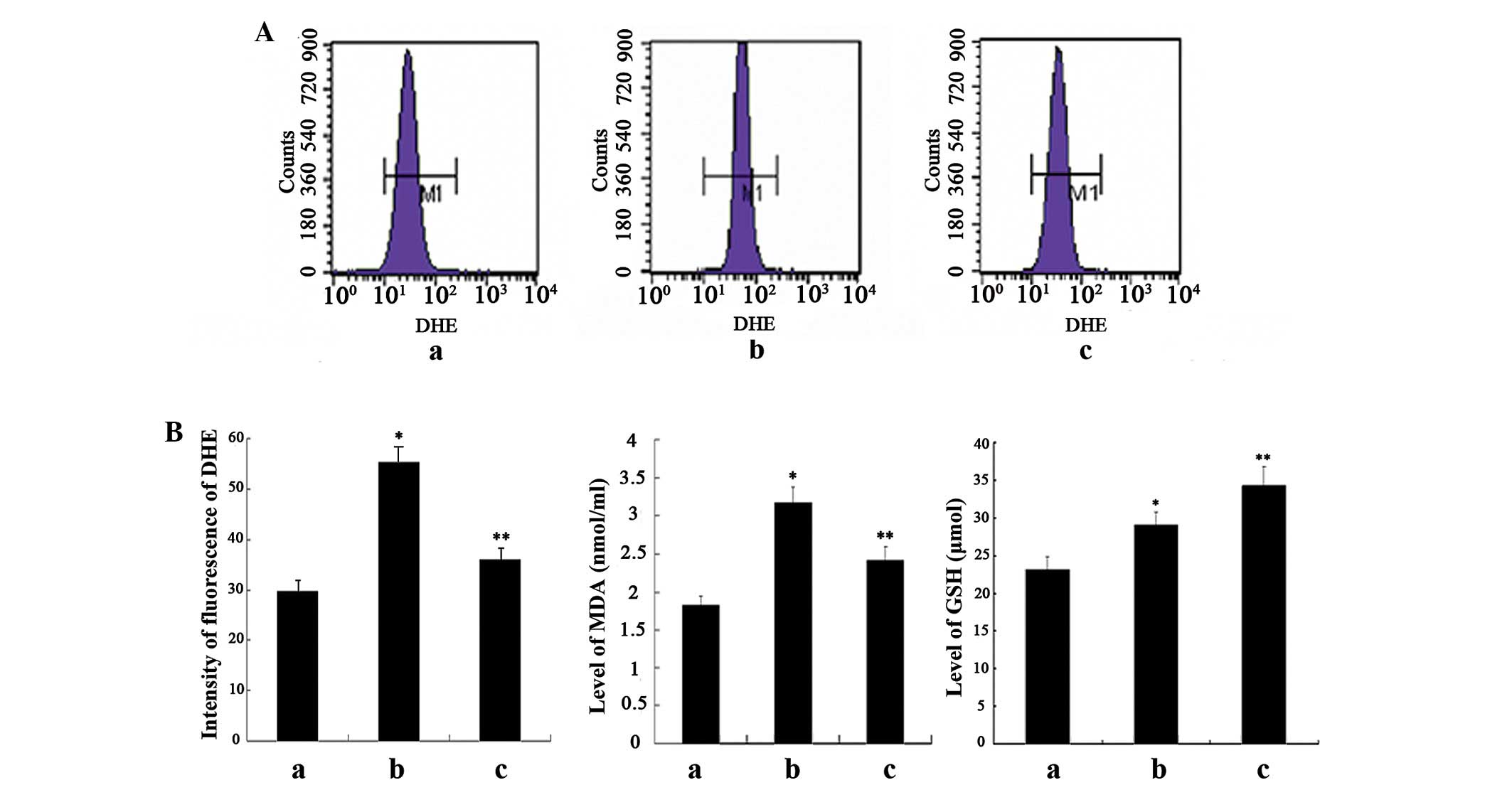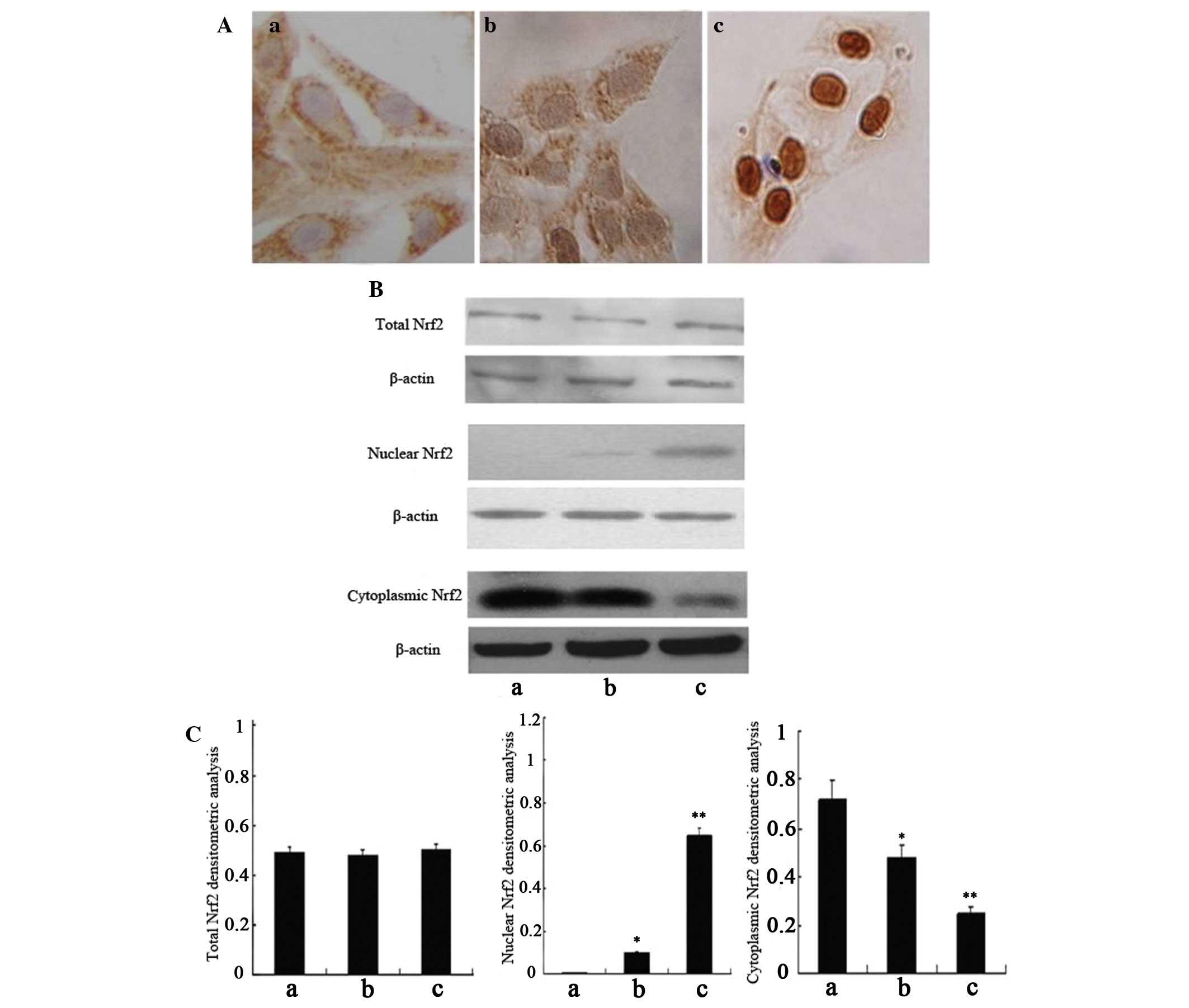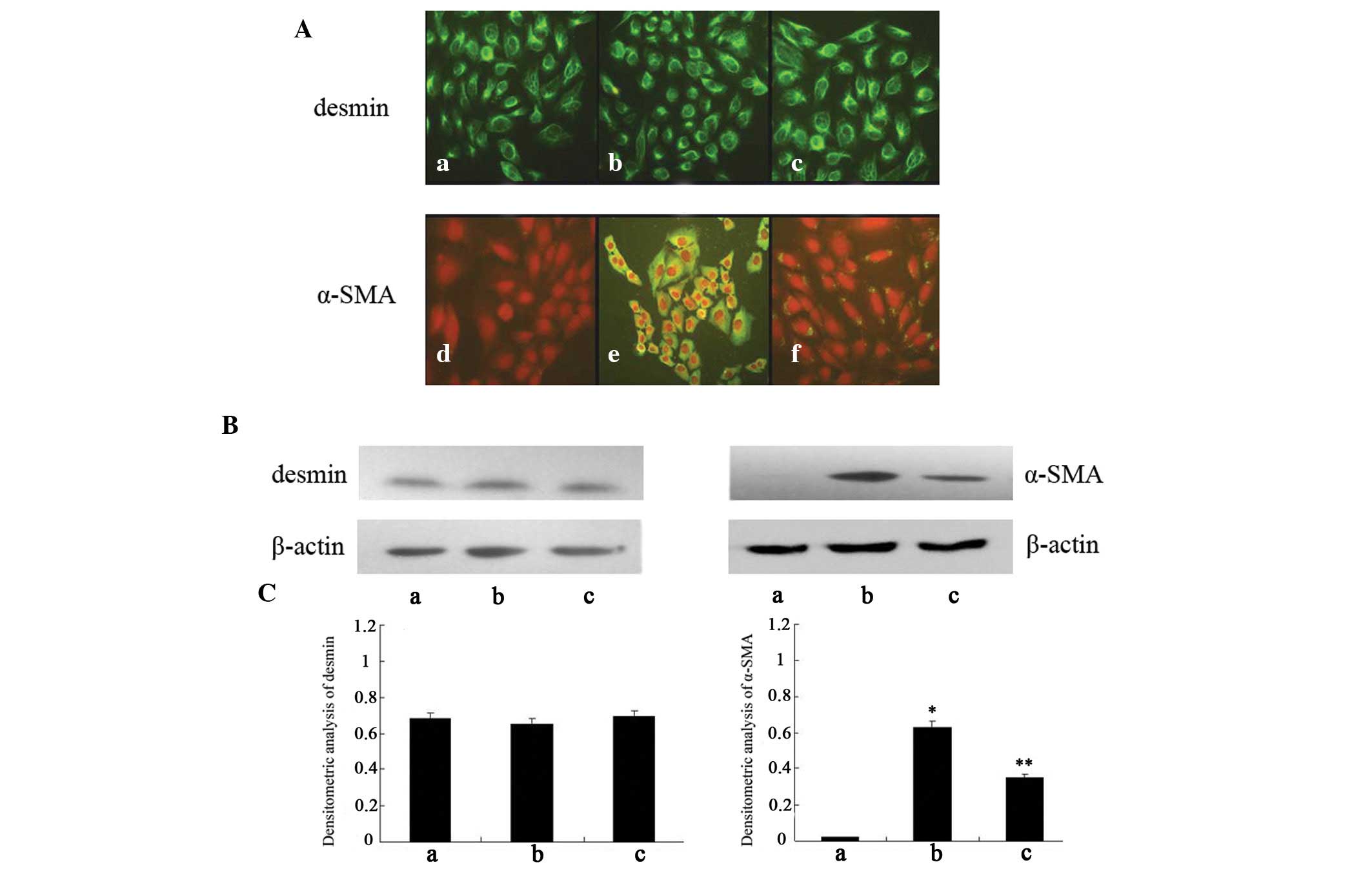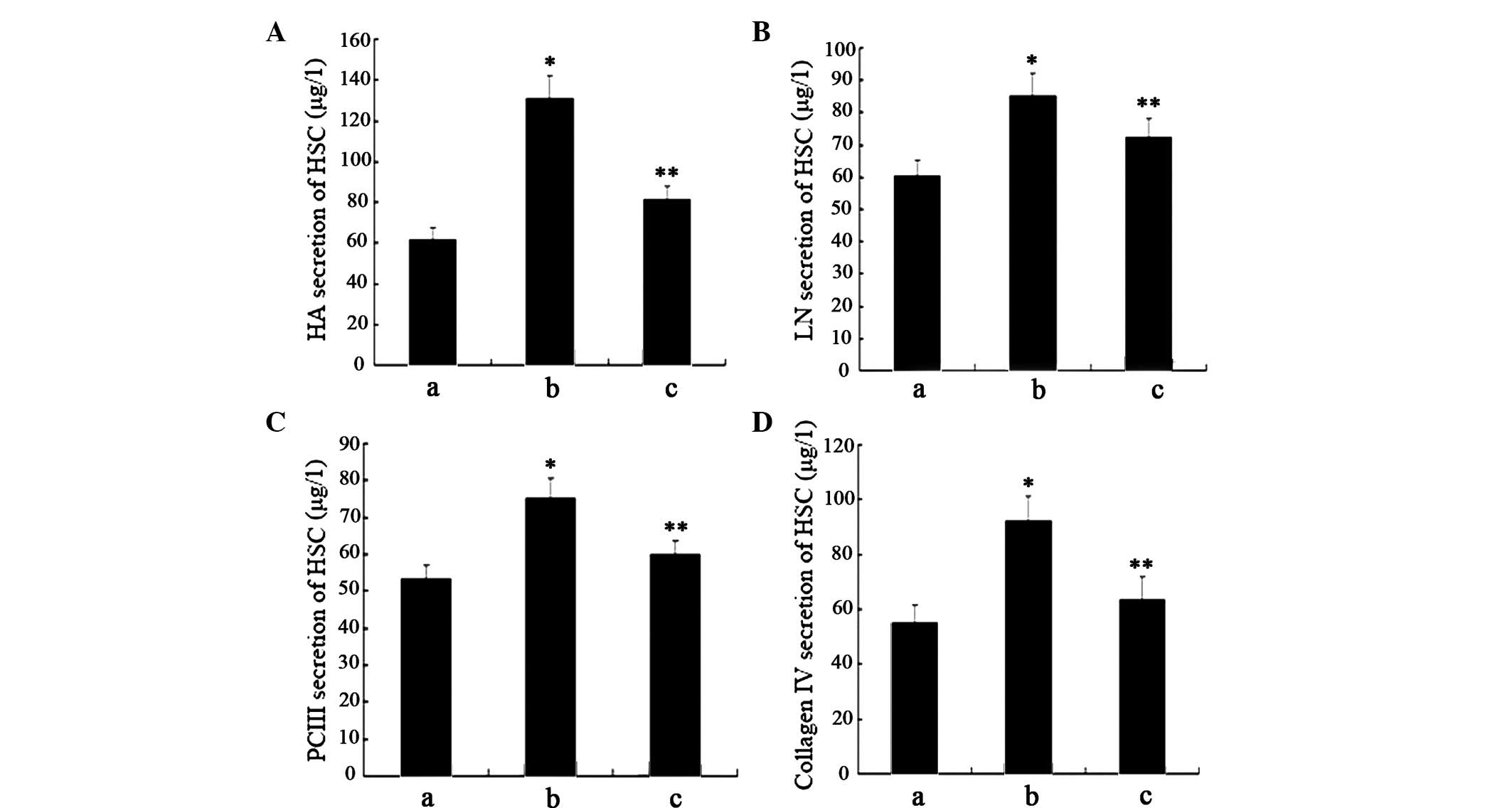|
1
|
Parola M and Pinzani M: Hepatic wound
repair. Fibrogenesis Tissue Repair. 2:42009. View Article : Google Scholar : PubMed/NCBI
|
|
2
|
Loguercio C and Federico A: Oxidative
stress in viral and alcoholic hepatitis. Free Radic Biol Med.
34:1–10. 2003. View Article : Google Scholar
|
|
3
|
Lin X, Zhang S, Huang R, Wei L, Tan S,
Liang S, Tian Y, Wu X, Lu Z and Huang Q: Helenalin attenuates
alcohol-induced hepatic fibrosis by enhancing ethanol metabolism,
inhibiting oxidative stress and suppressing HSC activation.
Fitoterapia. 95:203–213. 2014. View Article : Google Scholar : PubMed/NCBI
|
|
4
|
Lee BH, Hsu WH, Hsu YW and Pan TM:
Suppression of dimerumic acid on hepatic fibrosis caused from
carboxymethyllysine (CML) by attenuating oxidative stress depends
on Nrf2 activation in hepatic stellate cells (HSCs). Food Chem
Toxicol. 62:413–419. 2013. View Article : Google Scholar : PubMed/NCBI
|
|
5
|
Bisbal C, Lambert K and Avignion A:
Antioxidants and glucose metabolism disorders. Curr Opin Clin Nutr
Metab Care. 13:439–446. 2010. View Article : Google Scholar : PubMed/NCBI
|
|
6
|
Anoush M, Eghbal MA, Fathiazad F, Hamzeiy
H and Kouzehkonani NS: The protective effects of garlic extract
against acetaminophen-induced oxidative stress and glutathione
depletion. Park J Biol Sci. 12:765–771. 2009. View Article : Google Scholar
|
|
7
|
Sun Q, Long Z, Wu H, Liu Y, Wang L, Zhang
X, Wang X and Hai C: Effect of alcohol on
diethylnitrosamine-induced hepatic toxicity: Critical role of ROS,
lipid accumulation, and mitochondrial dysfunction. Exp Toxicol
Pathol. 67:491–498. 2015. View Article : Google Scholar : PubMed/NCBI
|
|
8
|
Takemoto K, Hatano E, Iwaisako K, Takeiri
M, Noma N, Ohmae S, Toriguchi K, Tanabe K, Tanaka H, Seo S, et al:
Necrostatin-1 protects against reactive oxygen species
(ROS)-induced hepatotoxicity in acetaminophen-induced acute liver
failure. FEBS Open Bio. 4:777–787. 2014. View Article : Google Scholar : PubMed/NCBI
|
|
9
|
Liu J, Wang X, Liu R, Liu Y, Zhang T, Fu H
and Hai C: Oleanolic acid co-administration alleviates
ethanol-induced hepatic injury via Nrf-2 and ethanol-metabolizing
modulating in rats. Chem Biol Interact. 221:88–98. 2014. View Article : Google Scholar : PubMed/NCBI
|
|
10
|
Browning JD and Horton JD: Molecular
mediators of hepatic steatosis and liver injury. J Clin Invest.
114:147–152. 2004. View Article : Google Scholar : PubMed/NCBI
|
|
11
|
Singh S, Vrishni S, Singh BK, Rahman I and
Kakkar P: Nrf2-ARE stress response mechanism: A control point in
oxidative stress-mediated dysfunctions and chronic inflammatory
diseases. Free Radic Rec. 44:1267–1288. 2010. View Article : Google Scholar
|
|
12
|
Matsunami T, Sato Y, Ariga S, Sato T,
Kashimura H, Haseqawa Y and Yukawa M: Regulation of oxidative
stress and inflammation by hepatic adiponectin receptor 2 in an
animal model of nonalcoholic steatohepatitis. Int J Clin Exp
Pathol. 3:472–481. 2010.PubMed/NCBI
|
|
13
|
De Minicis S, Candelaresi C, Agostinelli
L, Taffetani S, Saccomanno S, Rychlicki C, Trozzi L, Marzioni M,
Benedetti A and Svegliati-Baroni G: Endoplasmic Reticulum stress
induces hepatic stellate cell apoptosis and contributes to fibrosis
resolution. Liver Int. 32:1574–1584. 2012. View Article : Google Scholar : PubMed/NCBI
|
|
14
|
Tacke F and Weiskirchen R: Liver fibrosis
- pathogenesis and novel therapeutic approaches. Internist (Berl).
51:21–29. 2010.In German. View Article : Google Scholar
|
|
15
|
Vargas MR and Johnson JA: The Nrf2-ARE
cytoprotective pathway in astrocytes. Expert Rev Mol Med.
11:e172009. View Article : Google Scholar : PubMed/NCBI
|
|
16
|
Klaassen CD and Reisman SA: Nrf2 the
rescue: Effects of the antioxidative/electrophilic response on the
liver. Toxicol Appl Pharmacol. 244:57–65. 2010. View Article : Google Scholar : PubMed/NCBI
|
|
17
|
Lamlé J, Marhenke S, Borlak J, von
Wasielewski R, Eriksson CJ, Geffers R, Manns MP, Yamamoto M and
Vogel A: Nuclear factor-eythroid 2-related factor 2 prevents
alcohol-induced fulminant liver injury. Gastrornterology.
134:1159–1168. 2008. View Article : Google Scholar
|
|
18
|
Bar-Sela G, Epelbaum R and Schaffer M:
Curcumin as an anti-cancer agent: Review of the gap between basic
and clinical applications. Curr Med Chem. 17:190–197. 2010.
View Article : Google Scholar : PubMed/NCBI
|
|
19
|
Rahman I: Antioxidant therapeutic advances
in COPD. Ther Adv Respir Dis. 2:351–374. 2008. View Article : Google Scholar
|
|
20
|
Ishiqaki N, Yamamoto N, Jin H, Uchida K,
Terai S and Sakaida I: Continuos intravenous infusion of atrial
natriuretic peptide (ANP) prevented liver fibrosis in rat. Biochem
Biophys Res Commun. 378:354–359. 2009. View Article : Google Scholar
|
|
21
|
Copple IM, Goldring CE, Kitteringham NR
and Park BK: The Nrf2-Keap1 defense pathway: Role in protection
against drug-induced toxicity. Toxicology. 246:24–33. 2008.
View Article : Google Scholar
|
|
22
|
Mazur W, Lindholm P, Vuorinen K,
Myllärniemi M, Salmenkivi K and Kinnula VL: Cell-specific elevation
of NRF2 and sulfiredoxin-1 as markers of oxidative stress in the
lungs of idiopathic pulmonary fibrosis and non-specific
interstitial pneumonia. APMIS. 118:703–712. 2010. View Article : Google Scholar : PubMed/NCBI
|
|
23
|
Churchman AT, Anwar AA, Li FY, Sato H,
Ishii T, Mann GE and Siow RC: Transforming growth factor-beta1
elicits Nrf2-mediated antioxidant responses in aortic smooth muscle
cells. J Cell Mol Med. 13:2282–2292. 2009. View Article : Google Scholar : PubMed/NCBI
|
|
24
|
Chen W, Sun Z, Wang XJ, Jiang T, Huang Z,
Fang D and Zhang DD: Direct interaction between Nrf2 and p21
(Cip1/WAF1) upregulates the Nrf2-mediated antioxidant response. Mol
Cell. 34:663–673. 2009. View Article : Google Scholar : PubMed/NCBI
|
|
25
|
Kaspar JW, Niture SK and Jaiswal AK: Nrf2:
INrf2 (Keap1) signaling in oxidative stress. Free Radic Biol Med.
47:1304–1309. 2009. View Article : Google Scholar : PubMed/NCBI
|
|
26
|
Katsuoka F, Motohashi H, Ishii T,
Aburatani H, Engel JD and Yamamoto M: Genetic evidence that small
maf proteins are essential for the activation of antioxidant
response element-dependent genes. Mol Cell Biol. 25:8044–8051.
2005. View Article : Google Scholar : PubMed/NCBI
|
|
27
|
Ruby AJ, Kuttan G, Babu KD, Rajasekharan
KN and Kuttan R: Anti-tumor and antioxidant activity of natural
curcuminoids. Cancer Lett. 94:79–83. 1995. View Article : Google Scholar : PubMed/NCBI
|
|
28
|
Joe B, Rao UJ and Lokesh BR: Presence of
acidic glycoprotein in the serum of arthritic rats: Modulation by
capsaicin and curcumin. Mol Cell Biochem. 169:125–134. 1997.
View Article : Google Scholar : PubMed/NCBI
|
|
29
|
Xu YX, Pindolina KR, Janakiraman N, Noth
C, Chapman RA and Gautam SC: Curcumin, a compound with
anti-inflammatory and anti-oxidant properties, down-regulates
chemokine expression in bone marrow stromal cell. Exp Hematol.
25:413–422. 1997.PubMed/NCBI
|
|
30
|
Dujic J, Kippenberger S, Ramirez-Bosca A,
Diaz-Alperi J, Bereiter-Hahn J, Kaufmann R, Bernd A and Hofmann M:
Curcumin in combination with visible light inhibits tumor growth in
a xenograft tumor model. Int J Cancer. 124:1422–1428. 2009.
View Article : Google Scholar
|
|
31
|
Fan X, Zhang C, Liu DB, Yan J and Liang
HP: The clinical applications of curcumin: Current state and the
future. Curr Pharm Des. 19:2011–2031. 2013.
|
|
32
|
Cheng AL, Hsu CH, Lin JK, Hsu MM, Ho YF,
Shen TS, Ko JY, Lin JT, Lin BR, Ming-Shiang W, et al: Phase I
clinical trial of curcumin, a chemopreventive agent, in patients
with high-risk or pre-malignant lesions. Anticancer Res.
21:2895–2900. 2001.PubMed/NCBI
|
|
33
|
Dhillon N, Aggarwal BB, Newman RA, Wolff
RA, Kunnumakkara AB, Abbruzzese JL, Ng CS, Badmaev V and Kurzrock
R: Phase II trial of curcumin in patients with advanced pancreatic
cancer. Clin Cancer Res. 14:4491–4499. 2008. View Article : Google Scholar : PubMed/NCBI
|
|
34
|
Hanai H, Iida T, Takeuchi K, Watanabe F,
Maruyama Y, Andoh A, Tsujikawa T, Fujiyama Y, Mitsuyama K, Sata M,
et al: Curcumin maintenance therapy for ulcerative colitis:
Randomized, multi-center, double-blind, placebo-controlled trial.
Clin Gastroenterol Hepatol. 4:1502–1506. 2006. View Article : Google Scholar : PubMed/NCBI
|
|
35
|
Bundy R, Walker AF, Middleton RW and Booth
J: Turmeric extract may improve irritable bowel syndrome
symptomology in otherwise healthy adults: A pilot study. J Altern
Complement Med. 10:1015–1018. 2004. View Article : Google Scholar
|
|
36
|
Balogun E, Hoque M, Gong P, Killeen E,
Green CJ, Foresti R, Alam J and Motterlini R: Curcumin activates
the haem oxygenase-1 gene via regulation of Nrf2 and the
antioxidant-responsive element. Biochem J. 371:887–895. 2003.
View Article : Google Scholar : PubMed/NCBI
|
|
37
|
Ma ZC, Hong Q, Wang YG, Tan HL, Xiao CR,
Liang QD, Zhang BL and Gao Y: Ferulic acid protects human umbilical
vein endothelial cells from radiation induced oxidative stress by
phosphatidylinositol 3-kinase and extracelluar signal-regulated
kinase pathways. Biol Pharm Bull. 33:29–34. 2010. View Article : Google Scholar
|
|
38
|
Stridh MH, Correa F, Nodin C, Weber SG,
Blomstrand F, Nilsson M and Sandberg M: Enhanced glutathione efflux
from astrocytes in culture by low extracellular Ca2+ and
curcumin. Neurochem Res. 35:1231–1238. 2010. View Article : Google Scholar : PubMed/NCBI
|
|
39
|
Ballatori N, Krance SM, Notenboom S, Shi
S, Tieu K and Hammond CL: Glutathione dysregulation and the
etiology and progression of human disease. Biol Chem. 390:191–214.
2009. View Article : Google Scholar : PubMed/NCBI
|
|
40
|
Bindoli A, Fukuto JM and Forman HJ: Thiol
chemistry in peroxidase catalysis and redox signaling. Antioxid
Redox Signal. 10:1549–1564. 2008. View Article : Google Scholar : PubMed/NCBI
|
|
41
|
Johnson JA, Johnson DA, Kraft AD, Calkins
MJ, Jakel RJ, Vargas MR and Chen PC: The Nrf2-ARE pathway: An
indicator and modulator of oxidative stress in neurodegeneration.
Ann N Y Acad Sci. 1147:61–69. 2008. View Article : Google Scholar : PubMed/NCBI
|
|
42
|
Kraft AD, Johnson DA and Johnson JA:
Nuclear factor E2-related factor 2-dependent antioxidant response
element activation by tert-butylhydroquinone and sulforaphane
occurring preferentially in astrocytes conditions neurons against
oxidative insult. J Neurosci. 24:1101–1112. 2004. View Article : Google Scholar : PubMed/NCBI
|
|
43
|
Reichard JF and Petersen DR: Hepatic
stellate cells lack AP-1 responsiveness to electrophiles and
phorbol 12-myristate-13-acetate. Biochem Biophys Res Commun.
322:842–853. 2004. View Article : Google Scholar : PubMed/NCBI
|
|
44
|
Maeda K, Koda M, Matono T, Sugihara T,
Yamamoto S, Ueki M, Murawaki Y, Yamashita N and Nishiyama S:
Preventive effects of ME3738 on hepatic fibrosis induced by bile
duct ligation in rats. Hepatol Res. 38:727–735. 2008. View Article : Google Scholar : PubMed/NCBI
|
|
45
|
Urtasun R, Conde de la Rosa L and Nieto N:
Oxidative and nitrosative stress and fibrogenic response. Clin
Liver Dis. 12:769–790. 2008. View Article : Google Scholar : PubMed/NCBI
|
|
46
|
Wang J, Leclercq I, Brymora JM, Xu N,
Ramezani-Moghadam M, London RM, Brigstock D and George J: Kupffer
cells mediate leptin-induced liver fibrosis. Gastroenterology.
137:713–723. 2009. View Article : Google Scholar : PubMed/NCBI
|
|
47
|
Beyer TA, Xu W, Teupser D, auf dem Keller
U, Bugnon P, Hildt E, Thiery J, Kan YW and Werner S: Impaired liver
regeneration in Nrf2 knockout mice: Role of ROS-mediated
insulin/IGF-1 resistance. EMBO J. 27:212–223. 2008. View Article : Google Scholar
|
|
48
|
Qin Y and Tian YP: Preventive effects of
chronic exogenous growth hormone levels on diet-induced hepatic
steatosis in rats. Lipids Health Dis. 9:782010. View Article : Google Scholar : PubMed/NCBI
|
|
49
|
Kulbacka J, Saczko J and Chwiłkowska A:
Oxidative stress in cells damage processes. Pol Merkur Lekarski.
27:44–47. 2009.In Polish. PubMed/NCBI
|
|
50
|
Moselhy SS and Ali HK: Hepatoprotective
effect of cinnamon extracts against carbon tetrachloride induced
oxidative stress and liver injury in rats. Biol Res. 42:93–98.
2009. View Article : Google Scholar : PubMed/NCBI
|
|
51
|
Sener G, Kabasakal L, Yüksel M, Gedik N
and Alican Y: Hepatic fibrosis in biliary-obstructed rats is
prevented by Ginkgo biloba treatment. World J Gastroenterol.
11:5444–5449. 2005. View Article : Google Scholar : PubMed/NCBI
|
|
52
|
Kim J, Seok YM, Jung KJ and Park KM:
Reactive oxygen species/oxidative stress contributes to progression
of kidney fibrosis following transient ischemic injury in mice. Am
J Physiol Renal Physoil. 297:F461–F470. 2009. View Article : Google Scholar
|
|
53
|
Osburn WO, Wakabayashi N, Misra V, Nilles
T, Biswal S, Trush MA and Kensler TW: Nrf2 regulates an adaptive
response protecting against oxidative damage following
diquat-mediated formation of superoxide anion. Arch Biochem
Biophys. 454:7–15. 2006. View Article : Google Scholar : PubMed/NCBI
|
|
54
|
Snyder JC, Zemke AC and Stripp BR:
Reparative capacity of airway epithelium impacts deposition and
remodeling of extracellular matrix. Am J Respir Cell Mol Biol.
40:633–642. 2009. View Article : Google Scholar :
|
|
55
|
Friedman SL: Mechanisms of hepatic
fibrogenesis. Gastroenterology. 134:1655–1669. 2008. View Article : Google Scholar : PubMed/NCBI
|
|
56
|
Wells RG: The role of matrix stiffness in
regulating cell behavior. Hepatology. 47:1394–1400. 2008.
View Article : Google Scholar : PubMed/NCBI
|













